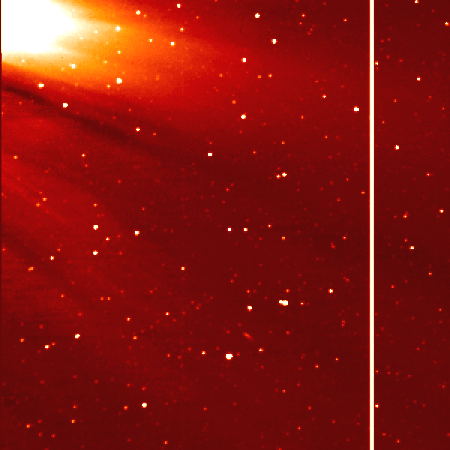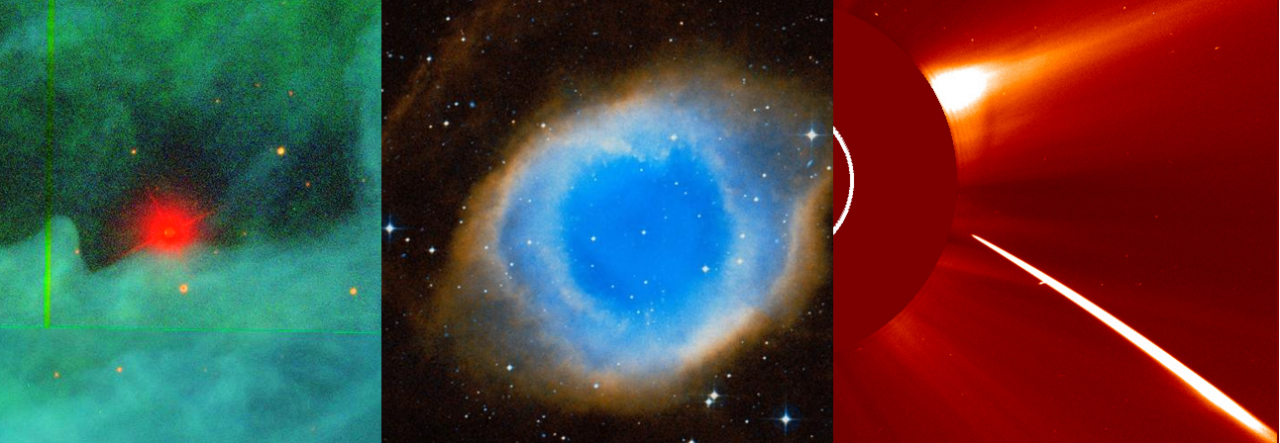Over the course of October 20th – 22nd, the SOHO/LASCO telescopes observed three pairs of near-sun comets. Two of the pairs were of the Kreutz-group, while the remaining were non-group comets. Additional cases were further observed on October 29th. Comet pairs, such as the ones seen here, result from larger precursor comets that underwent recent fragmentation events. The comets were all discovered via the Sungrazer Project.

Non-group Comet Pair (Oct 20-21)
On October 20th, amateur astronomer Jiangao Ruan reported three previously unknown non-group comets in real time SOHO/LASCO images. Two of these objects were a close pair of stellar-looking comets in C3 images, slowly arcing around the Sun (Fig. 2). Additionally, both objects were comparable in apparent brightness and followed a very similar trajectory. This suggests that these comets originated from a precursor that recently “split” into roughly two equal fragments.

Although close comet fragments are commonplace in the Kreutz-group, they are much more rarely observed in non-group objects. Several cases have however been observed. I suspect that the splitting event happened pre-perihelion, as the precursor comet was entering the “harsher” environments of the inner Solar System. Whether or not these objects survived their solar encounter will probably remain a mystery, as they are very likely intrinsically faint objects.
Bright Kreutz-group Comet and Leading Fragment (Oct 20-22)
On October 20th, amateur astronomer Hanjie Tan reported a new Kreutz-group in SOHO/LASCO C3 images. He found the comet near the edge of the FOV, which is unlike the majority of Kreutz comets (most are still too faint at that distance). This meant that it had the potential of becoming a relatively bright sungrazer.

Over the next couple of days, the comet brightened nicely. I’m guessing that it reached about mag +3 or +4 at its brightest. The comet displayed a bright head with an obvious tail (most likely a “debris trail”). The day following Hanjie’s report, amateur astronomer Worachate Boonplod reported a fainter leading companion in C3 images. Worachate’s object was rather fuzzy and showed a faint tail. Both comets entered the C2 FOV within a couple hours of each other, where they were observed to rapidly fade. Indeed, like all SOHO-discovered Kreutz-group comets, these objects did not survive their solar encounter (Fig. 4).

In addition their appearance in SOHO/LASCO, the pair was also nicely visible in STEREO/SECCHI HI1-A data (Fig. 5). The bright comet could also be tracked in COR2-A images.

Faint Kreutz-group Comet Pair (Oct 21st)
On October 21st, a couple of very close Kreutz-group fragments were briefly observed by the SOHO/LASCO C2 instrument (Fig. 6). The pair was reported by amateur astronomer Zesheng Zhang on October 22nd. Their diffuse nature suggests that they had likely been reduced to debris prior to entering the C2 FOV.

October 29th: A flurry of Kreutz-group Comets
On October 27th, Hanjie Tan reported another bright Kreutz-group comet in SOHO/LASCO C3 images. The comet was comparable in brightness to his previous find (Fig. 4), and was also preceded by a fainter leading fragment (found by Worachate Boonplod). Hanjie’s comet displayed a bright head and a narrow tail (i.e. debris trail). In C2 the head progressively faded as it approached the Sun. The leading comet was very elongated and diffuse, indicating that it had already disintegrated. Amateur astronomer Peter Berrett later spotted a fainter Kreutz comet that followed the pair by several hours (Fig. 7).

Several hours preceding the bright Kreutz [and its leading fragment], a close pair Kreutz-group fragments made an appearance in the C2 FOV. Both comets were short-lived and entered the FOV almost simultaneously. They were of comparable brightness, although one had an elongated appearance (Fig 8). Hanjie and Zesheng were the first to report these two comets.

References
This blog post is based on data from the Sungrazer Project report page, as well as my own interpretations of the SOHO/LASCO and STEREO/SECCHI data.
(c) Trygve Prestgard (2022). All rights reserved.

Great work. Excellent informative writeup
LikeLiked by 1 person
Thank you! 🙂
LikeLike
Pingback: Die „Säulen“ von Webb, nun von 7.7 bis 15 µm | Skyweek Zwei Punkt Null
A very nice article, thank you Trygve.
LikeLiked by 1 person
Thanks Honkit! 🙂
LikeLike